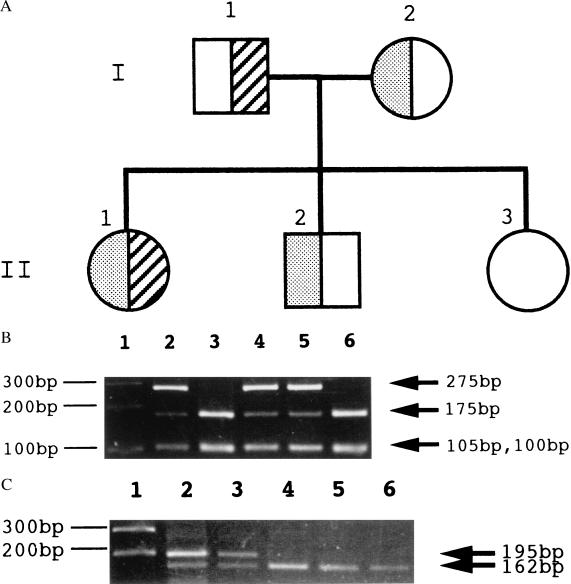Figure 3.
c-mpl gene mutations in the family with CAMT. (A) A pedigree of the family. Circles represent females and squares males. Half-shaded (left side of the symbol) symbols represent carriers of the Q186X mutation, and half-hatched (right side of the symbol) symbols represent carriers of the 1,499 delT mutation. The proband is II-1. (B) Verification of the C-to-T mutation at cDNA position 556 by PCR amplification and restriction-enzyme analysis. PCR products of exon 4 were digested with PvuII and checked by agarose gel electrophoresis. The 380-bp PCR product of exon 4 is cleaved to 175-bp, 105-bp, and 100-bp fragments by PvuII. The Q186X mutation abolishes one of two PvuII sites, resulting in 275-bp and 105-bp fragments. The patient (lane 2), her mother (lane 4), and her brother (lane 5) possess this mutation in one allele, whereas her father (lane 3) and her sister (lane 6) do not have this mutation. Lane 1 shows the molecular size marker. (C) Restriction-enzyme analysis of the 1,499 delT. The 265-bp PCR product of exon 10 is cleaved to 162-bp, 70-bp, and 33-bp fragments by Bfa I. The 1,499 delT abolishes one of two Bfa I sites, resulting in 195-bp and 70-bp fragments (70-bp and 33-bp bands are not shown). Although the patient (lane 2) and her father (lane 3) have this mutation in one allele, her mother (lane 4), her brother (lane 5), and her sister (lane 6) do not have this mutation. Lane 1 shows the molecular size marker.

